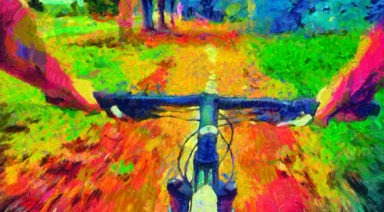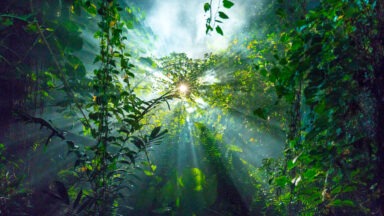Psychedelic Pharmaceuticals; Does a Psilocybin Drug Make Sense?

Psilocybin has an ancient and spiritual past that many believe to have a connection to the evolution of humankind. The chemical is a natural constituent of a fungus that often goes by the moniker “magic mushrooms,” and its effects range from anxiety relief to mystical experiences.
But now scientists have found a way to create psilocybin in a laboratory setting. And as with all artificially produced chemicals, the question arises as to whether scientists can replicate the intricacies, complexities, dynamism, and holism of organic ingredients that took nature eons to create.
With his team of researchers, Miami University professor Andrew Jones recently discovered a process to reliably produce psilocybin, which they refer to as a drug that could help treat depression.
Currently, methods of synthetically reproducing the chemical are in use but are relatively expensive. Jones said he was looking for a way to maintain “biological integrity” and reduce production costs, so he turned to metabolic engineering to increase a fungal cell’s ability to produce a compound of interest.
Follow the Money
Upon learning about these plans, those with a more naturalistic or holistic bent may ask: Why can’t mushrooms just be grown and harvested in natural conditions without the interference of scientists? Of course, the answer is rather simple: It’s all about the money.
Now that psilocybin has been recognized for its medicinal value, there’s huge profit potential in selling it. In order to carry out a business plan, there must be a way to increase yields and speed up production. Andrew Jones seems to have found a way to achieve both. He said, “Over the course of this study we improved production from only a few milligrams per liter to over a gram per liter, a nearly 500-fold increase.”
Miami University reported that Jones is pursuing the next phase of his psilocybin research by looking for ways to make E. coli bacteria a better host — the next step toward standardizing production levels that are “required by the pharmaceutical industry.”
Scientists argue that the university’s methodology isn’t a synthetic or artificial process. Instead, it’s a matter of splicing DNA. High Times magazine explained that after isolating the DNA sequence behind the production of psilocybin in mushrooms, the university’s “team did a simple copy/paste, splicing the mushroom DNA into the genome of E. coli. Then, they sat back and watched the E. coli work its mushroom magic, following the DNA’s instructions to produce psilocybin…By imbuing the humble E. coli bacterium with the psilocybin-producing power of a fungus, the researchers made the jump between two completely distinct domains of life.”
More Than Just a Recreational High
Psilocybin is naturally found in the mushroom Psilocybe cubensis, which grows wild in pastures and meadows. The mushroom is one of more than a hundred species that contain the psychoactive compounds psilocybin and psilocin. These “magic mushrooms” have long been used in Central American religious ceremonies, by ancient Japanese shamans, and by peoples across the globe.
While people use psilocybin mushrooms to produce a psychoactive effect that creates a mental and physical high, early human beings may have had a much more utilitarian and spiritual use. Some theorists, including Graham Hancock and Terence McKenna, believe mushrooms played a substantial role in the human species’ co-evolution with the planet (and all things natural).
McKenna made the case that psychedelics were instrumental in helping human beings evolve in consciousness and culture, “giving our mushroom-munching ancestors a leg up on rivals by enhancing their visual and linguistic capacities.”
Although most states in North America consider psilocybin mushrooms an illegal, controlled substance, these species of fungi are reportedly among the safest of mind-altering plants. They are non-addictive and nearly impossible (if at all possible) to overdose on, and can be home-grown. According to a substantial report by the Global Drug Survey, cited in Popular Science, people “tripping” on the mushroom are least likely to end up in the emergency room when compared to users of any other drug, including marijuana.
The Pharmacological Value of Magic Mushrooms
David Nutt, professor of neuropsychopharmacology at Imperial College London, said, “Psilocybin does in 30 seconds what antidepressants take three to four weeks to do.” A single dose of psilocybin, in addition to psychotherapy, can often resolve cases of depression and anxiety that resist standard treatment.
But anxiety is big business these days. The Anxiety and Depression Association of America reports that anxiety disorders are the most common mental illness in the United States, affecting 40 million adults in the United States who are age 18 and older — that’s 18.1 percent of the population every year. And people with an anxiety disorder are three to five times more likely to go to the doctor, and six times more likely to be hospitalized for psychiatric issues, than those who do not suffer from anxiety disorders.
Is the New Psilocybin Unnatural?
While the new way of producing psilocybin may not be called synthetic, it certainly isn’t natural. Scientists have once again inserted themselves between the natural process and the human organism. It may be said that it is pure hubris to do so, simply because the natural order involves evolution — a slow process of adaptation and mutation.
When scientists intervene in this process, then the variables leading to the possibilities of what can occur are incalculable. And the idea of holism — a fact of nature that has brought us to this point in the life of all species — is discarded by mainstream science in favor of isolating active plant constituents and/or circumventing the natural process.
Now, thanks to — or because of — Miami University’s scientific breakthrough, as with so many other artificially-created chemicals and genetically engineered plants, the psilocybin race is on. Only time will tell whether side effects may come out of the latest efforts to produce yet another heretofore natural substance outside of nature.
432 Hz Frequency: What It Is And How To Connect With Its Power

The 432 Hz frequency is a musical tuning used since ancient times by various cultures due to its harmonizing effect on the body and mind. Its sound resonates with mathematical patterns found in nature and is considered a tool for well-being and the expansion of consciousness. In this article, we explore what the 432 Hz frequency is, its uses, and how to incorporate it into daily life.
Table of Contents
- What Is The 432 Hz Frequency?
- What Is The 432 Hz Frequency Used For?
- Differences Between 432 Hz And 440 Hz Frequencies
- How To Use The 432 Hz Frequency In Your Daily Life
What Is The 432 Hz Frequency?
The 432 Hz frequency is a musical tuning that maintains a mathematical relationship with nature and the universe. It is in tune with the golden ratio, present in the structure of the human body and in patterns such as the Fibonacci sequence. Its sound is more harmonious and balanced compared to the standard 440 Hz tuning.
Different civilizations have used this frequency in their spiritual and ceremonial practices. In ancient Greece, Pythagorean music was based on mathematically perfect scales, while in Egypt and India specific sounds were used to induce deep meditative states. Many ancient instruments were designed to vibrate at 432 Hz, suggesting an intuitive understanding of its impact on consciousness.
In the series Sound of Creation, available on Gaia, experts like Gregg Braden and Dr. Robert Gilbert explore the relationship between sound, sacred geometry, and the vibration of the universe. Through scientific findings and ancestral knowledge, this series reveals how certain frequencies can influence perception and human well-being.
What Is The 432 Hz Frequency Used For?
The 432 Hz frequency has multiple applications for harmonizing the body and mind. Its balanced vibration influences emotional states, concentration, and energetic health. Below are some of its main functions:
- Deep relaxation: It lowers heart rate and brain activity, reducing stress and anxiety. Its sound has a calming effect that facilitates meditation.
- Enhanced concentration: It increases mental clarity and promotes focus. Listening to music in this frequency during study or work improves information retention.
- Energy balance: It aligns the flow of energy in the body and harmonizes the chakras. Its vibration restores physical and emotional well-being.
- Greater connection with nature: It resonates with the Earth’s frequency, strengthening the sense of unity with the environment. Listening to it outdoors enhances its beneficial effects.
- Induction to restorative sleep: It promotes progressive relaxation that facilitates deep rest. Using it before bedtime helps improve sleep quality and reduce anxiety before sleeping.
- Emotional healing: It releases accumulated tension and balances the nervous system. Its vibration works on the subconscious, promoting well-being and emotional balance.
- Creativity stimulation: It activates areas of the brain related to inspiration and imagination. It is ideal for boosting creativity in artistic and expressive disciplines.
Differences Between 432 Hz And 440 Hz Frequencies
The 432 Hz and 440 Hz frequencies are both used to tune musical instruments, but generate different effects in those who listen to them. Today, most music is tuned to 440 Hz, a standard officially adopted in the 20th century. However, 432 Hz has been used in various traditions for its more harmonic sound and its ability to induce relaxation.
Many people perceive music tuned to 432 Hz as softer and more balanced, whereas 440 Hz may feel more tense and stimulating. For this reason, 432 Hz is preferred in practices involving meditation, healing, and wellness. While both frequencies can trigger emotional and physical responses, 432 Hz has become a popular alternative for those seeking a more harmonious and profound sound experience.
How To Use The 432 Hz Frequency In Your Daily Life
Incorporating the 432 Hz frequency into your daily routine is a simple way to promote well-being and emotional balance. You can listen to music tuned to 432 Hz during meditation, upon waking, while working, or before sleeping. It’s also helpful in yoga sessions, massages, or any relaxation practice, as its vibration enhances focus and energetic harmony.
-
432 Hz Music For Meditation And Mental Balance
Meditating with 432 Hz music enhances relaxation and facilitates connection with the present moment. Its vibration induces a state of mental calm, reducing internal noise and allowing for a deeper meditative experience. Many people use it to relieve anxiety, improve focus, and enhance introspection.
An example of this frequency can be found in the series Fractal Universe: Meditations for Conscious Elevation, available on Gaia, where sound patterns and geometry are explored to facilitate deep meditative states. The first episode uses a frequency based on the Schumann resonance, related to the Earth’s natural vibration, allowing the mind to synchronize with a state of balance and expansion.
-
Using The 432 Hz Frequency For Energy Healing
The 432 Hz frequency is used in sound therapies to balance the body’s energy and release emotional blockages. It’s believed that its vibration harmonizes the chakras and improves the flow of vital energy, making it effective in practices like Reiki, sound bowl therapy, and vibrational healing sessions.
Listening to this frequency while practicing breathing or visualization exercises can enhance its effects. Its sound generates a sensation of well-being and stability, helping to restore emotional and physical balance. For this reason, many people incorporate it into their healing and self-discovery journey.
-
How To Listen To 432 Hz Music For Better Sleep
Music in 432 Hz is an effective tool to improve sleep quality and reduce anxiety before sleeping. Its soft, enveloping sound slows down mental activity, helping the body enter a state of deep relaxation. Listening to it for a few minutes before bed can ease the transition to sleep and reduce insomnia.
To enhance its effects, it’s advisable to create a quiet and distraction-free environment. You can combine the music with slow breathing exercises or nature sounds tuned to the same frequency. This practice calms the nervous system and promotes more restorative rest.




































